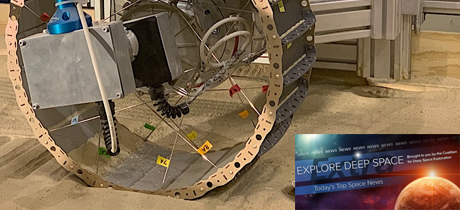In Today’s Deep Space Extra… James Webb Space Telescope continues to make it through a series of milestones leading up the unfolding of the complex primary mirror. Artemis water-seeking Moon rover VIPER undergoes wheel testing.
Space Science
James Webb Space Telescope deploys radiator to keep cool
Space.com (1/6): The James Webb Space Telescope (JWST) on Thursday successfully unfolded the Aft Deployable Instrument Radiator, a thermal control device for the observatory’s instrument suite. It was the latest in a series of milestones in the unfurling of the space telescope’s solar power panels, sunshade and light gathering mirrors following its December 25 launch from French Guiana. Friday and Saturday are to mark the unfolding of the JWST’s complex primary mirror.
Why doesn’t the James Webb Space Telescope have cameras onboard?
Space.com (1/6): The public is now used to seeing space up close, thanks to cameras. Why doesn’t NASA’s giant new observatory have any cameras on board? It has to do with light and heat, according to Julie Van Campen, deputy commissioning manager for the James Webb Space Telescope at NASA’s Goddard Space Center in Maryland. Even if a camera was included on board, it might mess up the sensitive optics on Webb, which are sensitive in infrared to gaze back at the young universe. So the first challenge for an onboard camera would be overcoming that the telescope operates in the black. Another problem with deploying cameras would be interference with keeping Webb cool. “Plastics fall apart” in the cold, Van Campen said, “and they shrink and crack glues.”
Why don’t green comets have green rails?
Universe Today (1/6): It’s the chemical compounds in comets that can glow green when they experience a rise in temperature as they near the sun and become ionized. But it’s not comet tails that emit the greenish glow and that is because the compounds are broken up by ultraviolet radiation from the sun by the time they make their way to the tail.
Other News
Report finds that U.S. accounts for more than half of global space spending
Ars Technica (1/6): Global governments spent $92 billion on space activities over 2021, an annual increase of eight percent, according to Euroconsult, a market intelligence firm. The 2021 total was split between civil space activities, $53 billion, and military space activities, $39 billion. Geopolitical tensions are credited with fueling much of the annual surge. Up 50 percent since 2015, the annual total is forecast to reach $110 billion by 2030.
All-metal wheels of the VIPER Moon rover spin for 25 miles in “high-tech sandbox”
Autoevolution (1/7): Using a Moon-mimicking set-up, one of the wheels on NASA’s water-seeking rover VIPER was tested over a three-week period. It clocked 25 miles of movement in a high-tech sandbox filled with lunar soil simulant, running through a battery of tests. They simulated slopes, wheel slips, and even the size, shape, and distribution of rocks the rover will encounter on the Moon. Minor weaknesses detected in the wheels during testing were addressed by VIPER’s mechanical design team with improvements that went into the rover’s final design. VIPER is set to be delivered to the surface of the Moon in late 2023 as part of the Commercial Lunar Payload Services (CLPS) initiative.
Chinese space station reaches for next stage of construction with robotic arm test
South China Morning Post (1/6): Astronauts aboard China’s now under construction Tiangong space station on Thursday successfully used the orbital outpost’s 33-foot-long external robotic arm to move a cargo capsule. China plans to complete the assembly of Tiangong station this year as part of a launch manifest of more than 40 missions.
Space debris expert warns U.S. ‘woefully behind’ in efforts to clean up junk in orbit
SpaceNews.com (1/6): The U.S. must do more to help eliminate mounting orbital debris in Earth orbit, Darren McKnight, a senior technical fellow at LeoLabs and member of the International Academy of Astronautics’ Space Debris Committee, told a University of Washington Space Policy and Research Center hosted webcast on Thursday. The debris accumulation is becoming a threat to space business, and McKnight contends other countries are doing more than the U.S. to address it, pointing out efforts by the European and Japanese space agencies.

